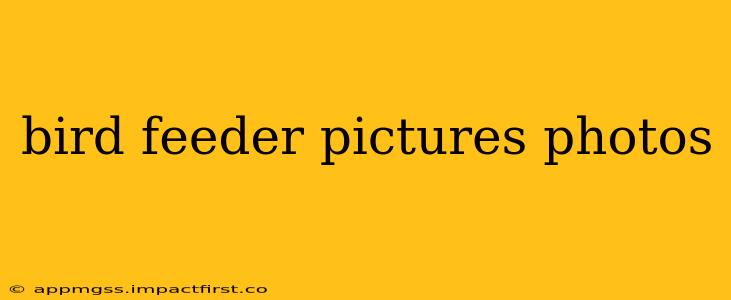Bird feeders aren't just for the birds; they're also a source of endless fascination for humans! From the intricate designs to the vibrant plumage of the feathered visitors, bird feeders offer a captivating spectacle that's perfect for photography. This post explores the beauty of bird feeder pictures and photos, offering tips for capturing stunning images and answering common questions about this popular photographic subject.
What are the best types of bird feeders for photography?
The best bird feeder for photography depends on your desired outcome. For close-up shots, a smaller feeder that brings birds closer is ideal. Tube feeders, suet feeders, and platform feeders all offer different opportunities. Tube feeders, in particular, often encourage birds to feed in a way that makes them easier to photograph. However, a larger platform feeder can attract a greater variety of birds, resulting in more diverse photographic subjects. Consider the size and species of birds prevalent in your area when making your selection.
What settings should I use on my camera to photograph birds at a feeder?
Capturing sharp images of birds in action requires a fast shutter speed to freeze their movement. A shutter speed of at least 1/500th of a second is generally recommended, but faster is better, especially in bright sunlight. A large aperture (small f-stop number, like f/2.8 or f/4) will help blur the background and keep the bird in sharp focus. Consider using continuous autofocus (AI Servo or similar) to track the bird as it moves. Experiment with different ISO settings to find a balance between image sharpness and noise.
How can I attract more birds to my bird feeder for better photos?
Attracting a variety of birds requires offering a diverse food source. Different types of seeds, suet, nectar, and fruits can draw different species. The placement of your feeder is also crucial; locate it near shrubs or trees for birds to perch and feel safe. Avoid placing the feeder near windows to prevent collisions. Keeping the feeder clean and regularly refilled will encourage birds to visit consistently.
What kind of lens is best for bird photography at a feeder?
A telephoto lens is essential for bird photography, allowing you to get close-up shots without disturbing the birds. Lenses with a focal length of 200mm or longer are ideal. Longer lenses, such as 400mm or 600mm, provide even greater magnification, but can be heavier and more expensive. Consider a lens with image stabilization to compensate for camera shake, particularly helpful when using longer lenses.
What are some tips for composing compelling bird feeder photos?
Composition is key to any successful photograph. Use the rule of thirds to place the bird off-center for a more dynamic composition. Pay attention to the background; a cluttered background can distract from the bird. Look for opportunities to create leading lines or other compositional elements that draw the viewer's eye to the bird. Try different angles and perspectives to add variety to your photos.
How do I edit bird feeder photos for better results?
Post-processing can significantly enhance your bird feeder photographs. Adjusting brightness, contrast, and saturation can bring out the vibrancy of the bird's plumage and the surrounding environment. Careful cropping can improve composition and remove distracting elements. Noise reduction can help clean up any graininess in the image, particularly at higher ISO settings. Numerous software options, both free and paid, are available for editing. However, remember subtlety is key—avoid over-processing, which can make the image look unnatural.
By following these tips and experimenting with different techniques, you can capture stunning bird feeder pictures and photos that capture the beauty and wonder of these feathered friends. Remember, patience and observation are crucial for successful bird photography. Happy shooting!
